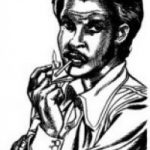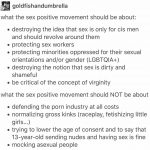I’m working through David Kunzle’s “World Upside Down: The Iconography of a European Broadsheet Type” in Barbara A Babcock’s “The Reversible World.” I’m not sure if I’m actually onto something, or just following a red herring.
WUD is a genre of broadsheet published all over Europe from the sixteenth to the early nineteenth century (if not later). It was a grid of images with captions, and not a comic strip in that there is no narrative connection between the images. Kunzle identifies several inversion motifs:
1. human to human (e.g. husband to wife, master to servant)
2. human to animal (e.g. hunter to hare, peasant to ox, woman to draft horse)
3. animal to animal (e.g. cock to hen, cat to mouse)
4. animal to element (e.g. fish in air, beasts in water)
5. animal to object (e.g. horse to cart)
6. object to object (e.g. tower to bell)
7. human to object (e.g. smith to anvil)
Types 1, 2 and 7 turn up a lot in fetish porn: femdom, ageplay/adult baby, pony/dog play, dehumanization. If you look at the work of, say, the House of Gord, you can see all of these themes, particularly types 2 and 7. The “femcar” is a modern version of ponyplay, the woman transformed into a component of a machine.
I think WUD imagery is a kind of prototype of pornography, horror and other “low” cultural forms. Kunzle puts them in opposition to books of proverbs, which demonstrate conservatism and the status quo, rather than the liberation and imagination of the WUD broadsheets. They were a popular form, and were connected to the peasant revolts of the early 1500s.
So, what’s the connection to kink? Maybe, some of the people seeing these images must have interpreted them as arousing. When the 19th century rolled around, bringing mass literacy, photography and the possibility of self-created media, people who connected with certain WUD images created more of those kind of images: femdom, pony girls, etc.
So where does maledom factor into this theory. A man dominating a woman is not an inversion of normality for human history. True, but there’s an additional element of inversion. If you look at the webcomics of Dofantasy.com, there’s a strong element of class inversion:
“A gang of lifers escape from a high security prison taking a bunch of beautiful young women as hostages…”
“They are at the top. They are the most beautiful and sought after young women on Earth… They have everything: fame, money, beauty, social recognition and a brilliant future… Kidnapped at gun point, roughly shackled and obscenely manhandled they are taken into a truck full of brutal, dirty, sweaty insurgents.”
“He has spotted new prey – a rich girl who had humiliated his alter ego on the subway that very same day…. In seconds the girl is caught and smuggled into the city sewers, where the villain has his hideaway.”
“The year is 1850. The place, a cotton plantation in the deep south. Mrs Scarlet O’Hanna is a rich estate owner whose husband died recently. She has two daughters, both beautiful and both sought after by young men of marriageable age. But the O’Hannas are a proud family, too good for the other families in the district…
Mrs O’Hanna runs her estate with stern hand, punishing the black slaves with great cruelty and a certain degree of sadism…
Her husband left a lot of debts and the estate will be confiscated. The estate, according to the sheriff, includes Scarlet and her young daughters Jennifer and Melissa…”
The majority of DoFantasy’s stories map class and race onto gender. The women are generally rich, beautiful and leisured, aristocrats, professionals or celebrities. The men are convicts, rebels, or even apes with human intelligence, to add an extra dimension of inversion. This is, of course, an homage to one of the kinkiest movies ever, which is also the WUD motif turned into a feature film: Planet of the Apes and its sequels and spin-offs.
What seems to be about gender at first actually seems to be about class, and specficially class revenge fantasies, which is a key theme in WUD imagery. This is what was happening in the early 16th century peasant revolts:
“The peasant bands, supported by urban proletariats, roved freely over large areas of Germany, burning and looting monasteries and castles… Peasant leader Jacklein Rohrbach, after degrading and executing the cruel Count Helfenstein, had the Countess, a daughter of the Emperor, dressed like a beggar (that is, one of their own) and sent on her way in a dung cart…. Knights in rags were compelled to serve their fassals at table. The peasants dressed themselves in knightly raiment and mimicked rituals.” Pg. 63-64



